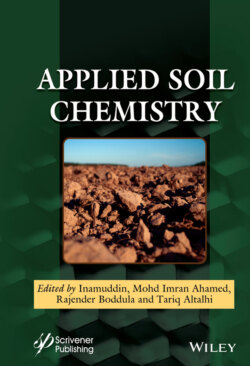Читать книгу Applied Soil Chemistry - Группа авторов - Страница 45
2.2.3 Clay Size Mineral Particles
ОглавлениеWhen the size of the particles of mineral becomes finer, then the sequence of stability of mineral becomes different relative to the coarsely grinded particle of mineral. This happens due to the enhancement of specific surface which increases the process of mineral weathering, which was comparatively more stable in coarsely grinded particle size. The particle size of clay minerals is below 200 diameters. According to Jackson et al., in the year 1948 and 1952 [37–39], the sequence of weathering consisted of 13 stages for clay size particles. The sequence is in descending order of stability:
Anatase (corundum, leucoxene, ilmenite, rutile, zircon, etc.)
Hematite (limonite, goethite, etc.)
Gibbsite (also allophane, boehmite, etc.)
Kaolinite
Montmorillonite (also saponite, beidellite, etc.)
Vermiculite and silicates interstratified 1:2 layer
Muscovite (also illite, sericite, etc.)
Quartz
Albite (also orthoclase, microline, stilbite, anorthite, etc.)
Biotite (also nontronite, antigorite, magnesium chlorite, glauconite, etc.)
Olivine-hornblende (also diopside, pyroxenes, etc.)
Calcite (also apatite, aragonite, dolomite, etc.)
Gypsum (also ammonium chloride, sodium nitrate, halite, etc.)
There are few modifications in the above list. Apatite was included at calcite stage; allophane was included in gibbsite stage by Tamura et al., in the year 1953 [40–42]. Marel et al., in the year 1947, and Haseman and Marshall, in the year 1943 [43–45], included zircon in Anatase stage. Woof and Carroll et al., in the year 1951 [46–48], and Marsden and Tyler, in the year 1938 [49–51], included leucoxene in the Anatase stage.
